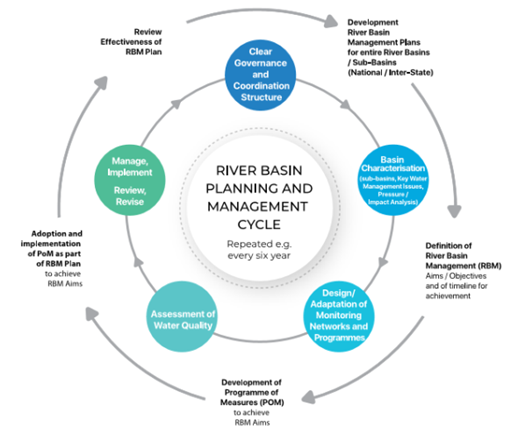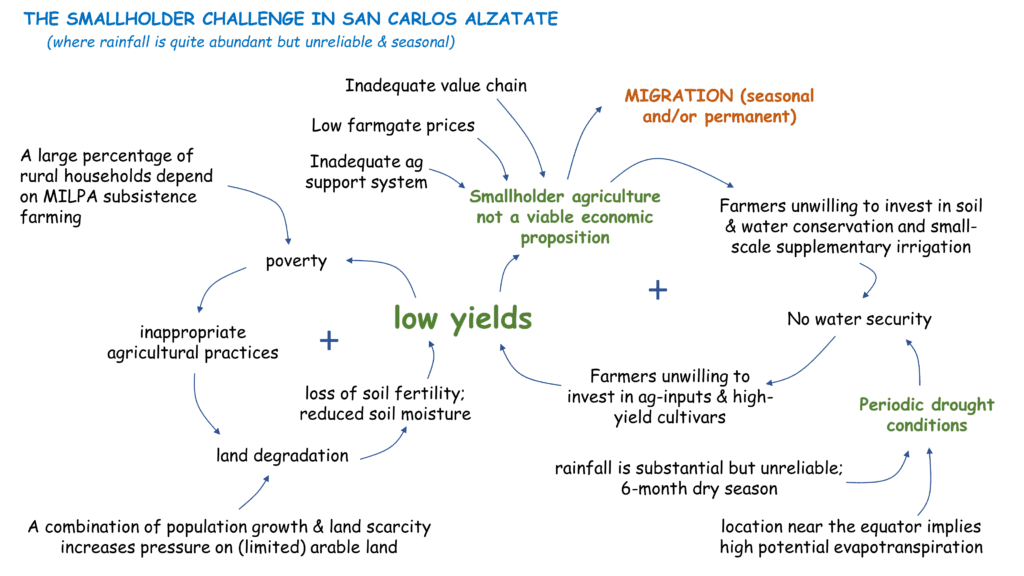Allan Savory delivered the 2020 Tony Coote Memorial lecture for the Mulloon Institute on 16 Sep 2020. It was an online event because of the Covid-19 pandemic and focused mostly on managing complex systems. For those involved in managing complex river basins, I would highly recommend watching this fascinating talk (you can find the youtube link at the bottom of this post).
Savory describes a few common elements in all (complex) decision-making processes:
- What is being managed are humans, nature, and/or economies.
- The above three entities are all ‘self-organizing complex systems’; hence all management challenges are concerned with managing complexity.
- For complex problems, leaders depend on advisors; advice is typically confusing or contradictory; often, decision makers do not get sound advice.
- On a large(r) scale, we can only manage through institutions (which themselves are, usually, complex systems characterized by wicked and intractable problems).
- As a rule, institutions resist (and ridicule) paradigm shifts and truly new knowledge that is opposed to commonly held beliefs. Institutions only change when societal views begin to change.
- Complex issues can only be solved if we address their root cause (a truism, I know; nevertheless, it is useful to include this observation in view of the point listed above).
- All human decision-making is similar in nature 1) we make decisions to achieve some objective, meet some need, or address a problem, 2) we use some tool, and 3) we base every decision on one or more of a great many factors (which can include intuition, past experience, expert advice, research results, cost, emotion, fear, cultural norms, laws, etc.).
- Humans are hard-wired to ignore the ‘web of complexity’ in societal, environmental, or economic systems and instead apply a reductionist approach; according to Allan Savory, ‘reductionist management is universal’.
- Reductionist thinking (and consequent reductionist policy development) is the reason why many societal, environmental, and economic problems remain unsolved.
According to Savory, the last two points explain why it has been so difficult to manage complex environmental systems. Seeing “the big picture” is just not what we (homo sapiens) do.
However, there are plenty of examples of successful highly complex natural-economic-societal systems. Take for instance the large metropolitan areas: New York City, London, Paris, etc. Or—to stay closer to water resources management—the highly productive and densely populated Rine-Schelde-Maas delta that comprises most of The Netherlands and that is, to make it even more complicated, mostly below sea level.
So, how did they do this?
Crucial to note here is that complex systems are built from the bottom-up through a process of tinkering and repetitive trial and error. There was never a top-down masterplan ‘at creation’ for these systems. Rather, they emerged over time and achieved long-term stability through frequent but small-scale volatility (Nassim Taleb).
A variation of Churchill’s quote “Americans will always do the right thing, only after they have tried everything else” probably also applies to environmental management. Given enough time, we (homo sapiens) will get it right.

However, given the unprecedented pressure on water and environmental resources and the urgency of the climate and biodiversity crises, we probably do not have enough time for this trial & error process. We need something to speed up the IWRM learning and tinkering process.
I think this is where Gerd Gigerenzer comes in.
“Fast and frugal heuristics”
Gigerenzer writes about “fast and frugal heuristics for making decisions under uncertainty”. He asserts that complex systems are simply too difficult to understand (and predict) and that it is therefore, by definition, impossible to analyze the full array of consequences of a decision in this ‘uncertain’ system. That’s part one of his argument.
The second part (of his argument) is concerned with the scarcity of mental resources, which, in his view, are insufficient to deliberately comprehend (let alone calculate) all consequences of a decision or, worse, of a suite of decisions. Thus, even if it would theoretically be possible to fully comprehend a complex system (which you cannot), you still cannot make a conscious rational decision because of cognitive limitations and lack of time.
The second argument is specifically pertinent for the water sector, where there are never enough resources (in terms of data, qualified staff, models, time, budget, insights, stakeholder inputs) for fully informed decision making. Instead, information is routinely incomplete or mostly absent, data are conflicting, insights are lacking, and deadlines are inevitably looming.
I think the similarities between the thinking of Gigerenzer and Savory are obvious. Savory asserts that humans are hard-wired to ignore complexity, while Gigerenzer thinks that homo sapiens lacks adequate cognitive abilities to (consciously) comprehend complex systems (they probably mean the same). Both agree that it’s simply not possible to fully understand these highly complex social-natural resources-economic-political systems anyway.
In response, Savory observes, humans’ resort to reductionist thinking that fails to solve complex problems.
Gigerenzer thinks we can do better by relying on intuition and smart rule of thumbs (heuristics) that ignore a lot of information.
One of the miracles of human intelligence is to know what to ignore (Gerd Gigerenzer)
Frugal thinking tools for WRM
Heuristics are mental shortcuts that aim to simplify cognitive processing. Gigerenzer defines them as “a strategy that ignores part of the information, with the goal of making decisions more quickly, frugally, and/or accurately than more complex methods.” Herbert Simon, who pioneered heuristics research, asserts that heuristics “are not optimizing techniques, but methods for arriving at satisfactory solutions with modest amounts of computation.”
But time constraints for water resources development decisions are less severe. After all, whether a decision (e.g. regarding the construction of an infrastructure element, a change in e-flow regime, or a water abstraction permit) is taken in the next 3 minutes or 3 months should not matter. Hence there is no need for fast heuristics. Rather, what are needed are ‘fast and frugal’ thinking tools. This is the domain of causal diagrams.
A causal diagram is a conceptual analysis presented as a graph. It is specifically useful to visualize a complex multi-sectoral problem. An example is provided below.

| San Carlos Alzatate San Carlos Alzatate is a municipality in Guatemala that is located at 14N° latitude with an average altitude of 1720 m above sea level. The municipality is situated in the upper part of the Rio Ostua basin. Rio Ostua is a tributary of Rio Lempa, shared by El Salvador, Guatemala, and Honduras. San Carlos Alzatate has a dominant rural population that mostly practices traditional MILPA subsistence farming (corn, beans, and squash, without agro-inputs). Average annual rainfall amounts to 1200 mm per year, but temporal and spatial variability of rainfall is high because of the mountainous terrain and seasonal nature of the rains. |
A causal diagram simplifies reality, ignores a lot of information, does not require computations, and does not provide probabilities. For all that, one can argue that it resembles a heuristic in the context of a complex multi-sectoral system—such as an environmental-water resources-social-economic system. A causal diagram provides a framework that allows for structured, quick, and frugal decision making.
Going back to Savory’s observations at the start of this post, a causal diagram helps seeing the bigger picture and therefore counteracts reductionist thinking (points 6, 8, and 9), and facilitates a structured discussion among experts and stakeholders that could greatly improve and unify advise to decision makers (point 3).
Further, a causal diagram can support the political dialogue inherent to water resources decision making.
Toolbox of fast and frugal thinking tools for WRM
Obviously, every problem requires a different causal diagram. Combined, they comprise a toolbox of frugal thinking-tools for water resources management. A good water manager will know “what tool to use for what problem”.
Thus, rather than developing complex models or collecting fragmented information in bits and pieces, I would advocate to develop ‘fast and frugal thinking tools’ in the water resources sector. Causal diagrams are part of this toolbox. Hopefully this approach can address some of Savory’s concerns.
| Silos in Integrated Water Resources Management (IWRM): how to address this paradox? Emerging water insecurity outside arid and semi-arid regions is not necessarily caused by inadequate rainfall. In fact, rainfall in the sub-humid zone and beyond is substantial—although often unreliable—and the available water volumes should be adequate to support a wide range of socio-economic activities. It is more probable that emerging water insecurity in these non-arid climatic zones is caused by management difficulties and misuse of water resources. As a rule, management becomes paralyzed in the face of overwhelming complexity. Understanding the full web of interactions in a complex system is impossible. Hence managing complex natural systems—such as hydrological, environmental, or agricultural systems—has proven extremely difficult. It is probably beyond the capacity of most water resources agencies to manage water resources in a fully integrated manner, at all scales. There are simply too many relevant factors that need to be taken into consideration, despite the introduction of concepts such as Integrated Water Resources Management. In practice, therefore, water agencies follow the reductionist approach. Complex systems are split into many smaller sub-systems—typically by sector—which are then managed separately. This approach probably corresponds with human nature, but it does not appreciate the intrinsic holistic character of a complex system. Hence this management approach is inadequate and generally leads to ineffective solutions that do not produce the anticipated outcome. This failure is not because of a lack of specific technical knowledge. Rather, it seems an intrinsic feature of an overly complex natural system, where we simply do not understand the full web or interactions, and we therefore do not understand the full spectrum of implications of specific management decisions. How to re-introduce a more holistic approach? As proposed in this post, a toolbox of ‘fast and frugal’ thinking tools including a set of diverse causal diagrams could be very useful, specifically when used in a facilitated dialogue process (workshop). |
References
Gerd Gigerenzer, Simple heuristics that make us smart; Oxford University Press; First Edition (September 30, 1999)
Gerd Gigerenzer, Risk savvy, how to make good decisions; Viking Penquin; 2014
